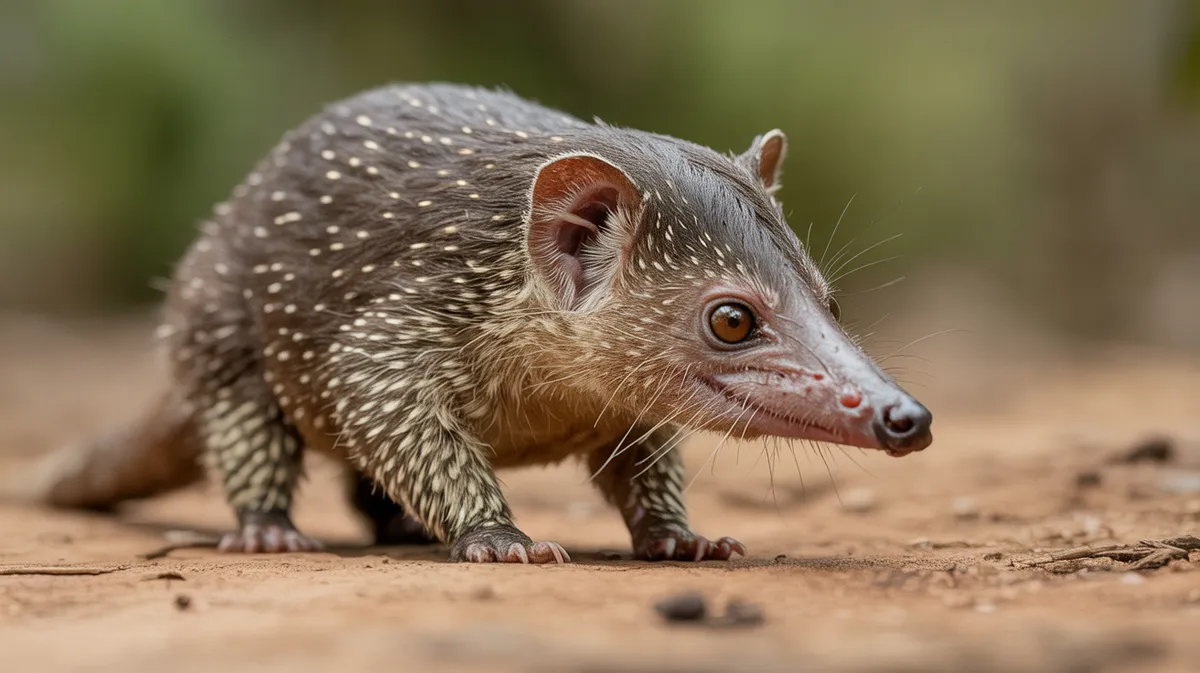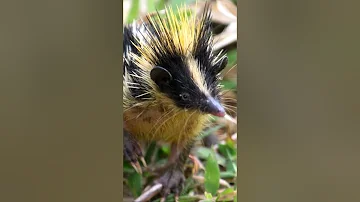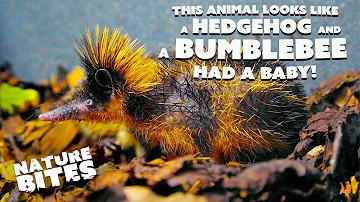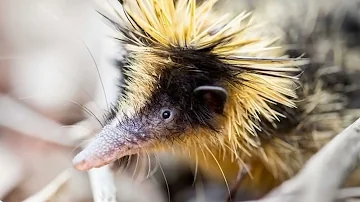
Common Tenrec
Tenrec ecaudatus

Meet the Common Tenrec
The Common Tenrec is a small, nocturnal mammal native to Madagascar, notable for its hedgehog-like appearance with a spiny coat and a long, pointed snout. Despite its resemblance to hedgehogs, it is not closely related and belongs to a unique family endemic to Madagascar. It can adapt to a variety of environments, from rainforests to agricultural areas, and is recognized for its remarkable reproductive capacity. The Common Tenrec is primarily terrestrial, foraging at night for insects, worms, and a variety of plant material. It is also known for entering periods of torpor to survive cooler or drier seasons.
Classification
Mammal
Habitat
Tropical forest and scrubland
Diet
Omnivore
Lifespan
3-8 years
Conservation
Least Concern
Weight
1.0–2.5 kg
📖Fascinating Facts
Huge Litters
The Common Tenrec can give birth to up to 32 offspring at once, the largest litter size of any terrestrial mammal.
Nocturnal Forager
This species is most active at night, searching for insects, small animals, fruit, and roots under the cover of darkness.
Cold-Blooded Traits
Unlike most mammals, the Common Tenrec can allow its body temperature to drop to match its environment, similar to reptiles.
📋Detailed Description
The Common Tenrec (Tenrec ecaudatus) is the largest member of the Tenrecidae family, with adults typically measuring 25–39 cm in length and weighing between 1.0 and 2.5 kg, though some individuals can exceed 3 kg. Its robust, cylindrical body is covered in coarse, spiny hairs interspersed with softer fur, providing both protection from predators and insulation. The species is tailless, as its common name suggests, and possesses a long, flexible snout adapted for probing soil and leaf litter. The limbs are short and strong, with five toes on each foot, well-suited for digging and foraging. Tenrecs have poor eyesight but an acute sense of smell and hearing, which they rely on for nocturnal activity. Their body temperature is unusually variable for a mammal, sometimes dropping to ambient levels, a trait linked to their ability to enter torpor or hibernation. The dental formula is distinctive (I 3/3, C 1/1, P 3/3, M 3/3), reflecting their omnivorous diet. Despite their hedgehog-like appearance, tenrecs are more closely related to African golden moles and share a distant evolutionary lineage with Afrotherian mammals.
💡 Did you know?
Despite being a mammal, the Common Tenrec does not have a fixed body temperature and can adjust its temperature much like reptiles.
🔬Research & Sources
Wikipedia Summary
The tailless tenrec, also known as the common tenrec, is a species of mammal in the family Tenrecidae. It is the only member of the genus Tenrec. Native to Madagascar, it is also found on the Comoros, Mauritius, Réunion, and Seychelles island groups, where it has been purposely introduced. Its natural habitat is the understory of subtropical-tropical forest, open forest, arid shrub-land, savanna, arable land, pastures, crop plantations, private gardens, and some landscaped, urban areas.
Last Modified: 3/23/2025
🎭Behavior & Social Structure
Common Tenrecs are primarily nocturnal and terrestrial, spending daylight hours sheltering in burrows, dense vegetation, or under logs. They are solitary for most of the year, with home ranges that may overlap slightly but are generally defended. Foraging occurs mainly at night, when they use their sensitive snouts to locate invertebrates such as earthworms, insects, and mollusks, as well as fruit, seeds, and occasionally small vertebrates. They are opportunistic feeders, adapting their diet to seasonal availability. Tenrecs are capable swimmers and may enter water to escape predators or search for food. Communication is mainly through scent marking and a range of vocalizations, including grunts, squeaks, and hisses, particularly during the breeding season or when threatened. When alarmed, they may erect their spines and emit sharp sounds as a deterrent.
👶Reproduction & Life Cycle
The reproductive biology of the Common Tenrec is remarkable among mammals. Breeding is highly seasonal, typically coinciding with the onset of the rainy season (October to December in Madagascar), when food is most abundant. After a gestation period of approximately 50–65 days, females give birth to exceptionally large litters, ranging from 15 to 32 offspring—one of the highest for any placental mammal. The young are born blind and helpless in a nest constructed from vegetation, and are cared for exclusively by the mother. Lactation lasts about 3–4 weeks, after which the juveniles begin to forage independently. Sexual maturity is reached within the first year. The high reproductive output is thought to be an adaptation to high predation rates and environmental variability.
🛡️Adaptations & Survival
Tenrec ecaudatus exhibits several adaptations for survival in Madagascar's diverse habitats. Its spiny pelage provides defense against predators, while cryptic coloration aids in camouflage. The ability to enter torpor or hibernate for extended periods (up to nine months in captivity) allows survival during periods of food scarcity or drought. Its variable body temperature and low metabolic rate are unusual for mammals and reduce energy requirements. The highly flexible snout and strong forelimbs facilitate efficient foraging in soil and leaf litter. Reproductive strategies, such as large litter sizes and rapid maturation, compensate for high juvenile mortality. Behavioral plasticity enables the species to thrive in both natural forests and human-altered landscapes.
📚Research Sources
🎨Cultural Significance
In Madagascar, the Common Tenrec is an important source of protein and is widely hunted and consumed, especially during the breeding season when it is most plentiful. It features in Malagasy folklore and is sometimes associated with fertility and abundance due to its prolific breeding. In some communities, tenrec meat is considered a delicacy, and traditional hunting methods are passed down through generations. The species has also been introduced to other Indian Ocean islands for food, reflecting its economic and cultural value. There are no known uses in traditional medicine, but its presence in local markets underscores its significance in regional diets.
🔬Recent Research & Discoveries
Recent research has focused on the Common Tenrec's unique thermoregulatory physiology, revealing that it can exhibit both homeothermic and poikilothermic traits, a rare phenomenon among placental mammals. Studies of its genome have provided insights into Afrotherian evolution and mammalian diversification on Madagascar. Ongoing ecological research investigates its role in seed dispersal and soil aeration, as well as its interactions with introduced predators and competitors. Conservation genetics studies are assessing population structure and gene flow between native and introduced populations. The species' remarkable reproductive biology continues to be a subject of interest for understanding mammalian life history evolution.
🎥Wildlife Videos

Madagascan Tenrecs Use Quills To Communicate - Madagascar, Lost Worlds, Preview - BBC
#bbc.
BBC

Discover the Fascinating World of Tenrecs: Unusual Facts and Behaviors
Welcome to the fascinating world of tenrecs! In this video, we dive into the unique characteristics and behaviors of these incredible ...
Pets Home Video

Tiny Titans - The Fascinating World of Insects | Free Documentary Nature
Tiny Titans - The Fascinating World of Insects | Wildlife Documentary Watch 'Wildlife - Just Insects' here: ...
Free Documentary - Nature

Tenrecs on The Hunt for Love | Nature Bites
In this heartwarming video, zoo workers are on a mission to find a perfect match for a lovable tenrec. Follow along as they search ...
Nature Bites

Baby Tenrecs Feast on a Buffet of Worms After a Storm
Resembling a combination of a shrew and a hedgehog, tenrecs are native mammals to Madagascar, where 30 different species of ...
Smithsonian Channel

Tenrecs use - Quills To -Communicate #The streaked Tenrecs Animals of the week
The streaked Tenrecs is about the same size; it's fur consists of detachable barbed spines and coarse hairs - The common, ...
Beautiful Species in the world
🌍Habitat Information
The Common Tenrec typically inhabits Tropical forest and scrubland environments. Common Tenrecs have adapted to their environments with specialized features and behaviors.
Primary Habitat:
Tropical forest and scrubland
More detailed habitat information will be available soon.
🛡️Conservation Status
The Common Tenrec is currently classified as Least Concern. Conservation efforts are crucial for preserving this species for future generations.
Common Threats:
- 🏠Habitat loss and fragmentation
- 🌡️Climate change impacts
- 🎯Hunting and poaching
- 🏭Human-wildlife conflict
⚠️Threats & Conservation Challenges
Currently classified as Least Concern by the IUCN, the Common Tenrec is widespread and adaptable, with stable populations across its native and introduced ranges. However, local threats include habitat loss due to deforestation, agricultural expansion, and urbanization. In some regions, tenrecs are hunted for food, particularly during the breeding season when they are most abundant. Introduced populations may impact native fauna through competition and predation. Despite these pressures, the species' high reproductive rate and ecological flexibility have allowed it to persist. Ongoing monitoring is recommended to detect any future population declines, especially in areas experiencing rapid environmental change.
🔬Scientific Classification
Scientific Name
Tenrec ecaudatus
Classification Hierarchy
🔍 About Taxonomic Classification
Taxonomic classification is a hierarchical system used by scientists to classify and organize living organisms based on shared characteristics and evolutionary relationships.
The system moves from broad categories (Kingdom) to increasingly specific ones, with each animal's scientific name typically consisting of its Genus and species.
📝Community Notes
Share your observations and insights about the Common Tenrec with our community of wildlife enthusiasts.
Join Our Community
Sign in to share your observations and connect with fellow wildlife enthusiasts.
Sign In to ContributeNo community notes yet
Be the first to share your observations about the Common Tenrec!
Explore Common Tenrec
Select a tab above to learn more about this amazing animal.
📸Photo Gallery
No photos available for this animal yet.
🌟Discover More Wildlife
Continue your journey of discovery with more fascinating animals from our database
